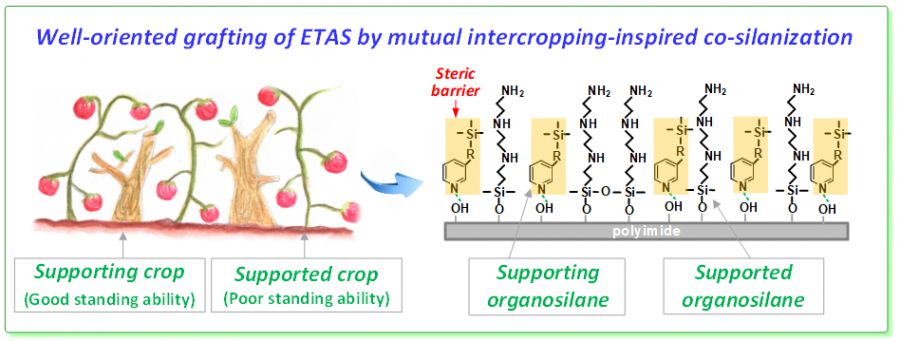設施農業:節能栽培與滅菌【化學工程學系/陳志銘特聘教授】
| 論文篇名 | 英文:Mutual Intercropping-inspired Co-silanization to Graft Well-oriented Organosilane as Adhesion Promotion Nanolayer for Flexible Conductors 中文:交互間作啟發之共矽烷化製程接枝規則排列之有機矽烷作為軟性導線之奈米附著強化層 |
| 期刊名稱 | JOURNAL OF INDUSTRIAL AND ENGINEERING CHEMISTRY |
| 發表年份,卷數,起迄頁數 | 2020, 83: 90-99 |
| 作者 | Chen, Yi-Hsuan; Lai, Yi-Hsiang; Wu, Ping-Heng; Chen, Li-Syuan; Lin, Yung-Sen; Chen, Chih-Ming(陳志銘)* |
| DOI | 10.1016/j.jiec.2019.11.017 |
| 中文摘要 | 高分子基材的表面金屬化和薄膜的附著力對於柔性電子的發展至關重要。本研究證明通過在兩個有機矽烷分子之間相互穿插來改善聚醯亞胺膜的共矽烷化工程,以改善它們的接枝方向性並增強對聚醯亞胺基材和負載金屬原子的吸附性。通過使用3-[(三甲基甲矽烷基)乙炔基]吡啶作為支撐的有機矽烷,在空間上限制所支撐的氨基矽烷3- [2-(2-(2-氨基乙基氨基)乙氨基]丙基三甲氧基矽烷,以形成良好方向取向的有機矽烷複合奈米層作為柔性導體的黏合促進層。與單矽烷化(0.51 kgf/cm)和濺射Ta/Cu(0.4 kgf/cm)的銅導體相比,在聚醯亞胺膜上通過共矽烷化化學沉積柔性的銅導體顯示出更高的黏合強度(0.9 kgf/cm)。對於共矽烷化的銅/聚醯亞胺樣品,通過在高達1000次的彎曲循環後仍保持良好的電性能,也實現出色的變形性(彎曲性)。 |
| 英文摘要 | Surface metallization of polymer substrate and film adhesion are crucial to the development of flexible electronics. This study demonstrates the co-silanization engineering on the polyimide (PI) film by mutual intercropping of two organosilane molecules to improve their grafting orientability and enhance the adsorbability toward the PI substrate and loaded metal atoms. The mutual intercropping-inspired co-silanization engineering is implemented by using 3-[(trimethylsilyl)ethynyl]pyridine (TEP) as a supporting organosilane to spatially confine the grafting orientation of the supported aminosilane, 3-[2-(2-aminoethylamino)ethylamino]propyl-trimethoxysilane (ETAS), leading to the formation of a well-oriented organosilane composite nanolayer as adhesion promotion layer for flexible conductors. The flexible Cu conductor electrolessly deposited on the PI film by co-silanization shows improved adhesion strength (0.9 kgf/cm) compared to those based on mono-silanization (0.51 kgf/cm) and sputtered Ta/Cu (0.4 kgf/cm). Superior deformability (bendability) was also achieved for the co-silanized Cu/PI sample by retaining good electrical property after bending cycle up to 1000. |







